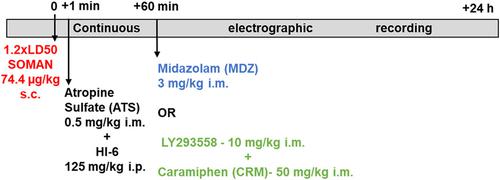当前位置:
X-MOL 学术
›
Ann. N. Y. Acad. Sci.
›
论文详情
Our official English website, www.x-mol.net, welcomes your
feedback! (Note: you will need to create a separate account there.)
Electroencephalographic analysis in soman-exposed 21-day-old rats and the effects of midazolam or LY293558 with caramiphen
Annals of the New York Academy of Sciences ( IF 4.1 ) Pub Date : 2020-03-31 , DOI: 10.1111/nyas.14331 Marcio De Araujo Furtado 1 , Vassiliki Aroniadou-Anderjaska 1, 2 , Taiza H. Figueiredo 1 , James P. Apland 3 , Maria F. M. Braga 1, 2
Annals of the New York Academy of Sciences ( IF 4.1 ) Pub Date : 2020-03-31 , DOI: 10.1111/nyas.14331 Marcio De Araujo Furtado 1 , Vassiliki Aroniadou-Anderjaska 1, 2 , Taiza H. Figueiredo 1 , James P. Apland 3 , Maria F. M. Braga 1, 2
Affiliation

|
Acute nerve agent exposure induces status epilepticus (SE), which can cause brain damage or death. Research aiming at developing effective therapies for controlling nerve agent–induced SE is commonly performed in adult rats. The characteristics of nerve agent–induced SE in young rats are less clear; relevant knowledge is necessary for developing effective pediatric therapies. Here, we have used electroencephalographic (EEG) recordings and analysis to study seizures in postnatal day 21 rats exposed to 1.2 × LD50 of soman, and compared the antiseizure efficacy of midazolam (MDZ)—currently considered by the Food and Drug Administration to replace diazepam for treating SE in victims of nerve agent exposure—with that of LY293558, an AMPA/GluK1 receptor antagonist, administered in combination with caramiphen, an antimuscarinic with N‐methyl‐d‐aspartate receptor antagonistic properties. Prolonged SE developed in 80% of the rats and was reflected in behavioral seizures/convulsions. Both MDZ and LY293558 + caramiphen stopped the SE induced by soman, but there was a significant recurrence of seizures within 24 h postexposure only in the MDZ‐treated group, as revealed in the raw EEG data and their representation in the frequency domain using a fast Fourier transform and in spectral analysis over 24 hours. In contrast to the high efficacy of LY293558 + caramiphen, MDZ is not an effective treatment for SE induced by soman in young animals.
中文翻译:

暴露于索曼的 21 日龄大鼠的脑电图分析以及咪达唑仑或 LY293558 与卡拉米芬的影响
急性神经毒剂暴露会诱发癫痫持续状态 (SE),这会导致脑损伤或死亡。旨在开发控制神经毒剂诱导的 SE 的有效疗法的研究通常在成年大鼠中进行。幼鼠神经毒剂诱发SE的特征尚不明确;相关知识对于开发有效的儿科疗法是必要的。在这里,我们使用脑电图 (EEG) 记录和分析来研究暴露于 1.2 × LD50 索曼的出生后第 21 天的大鼠的癫痫发作,并比较咪达唑仑 (MDZ) 的抗癫痫功效——目前美国食品和药物管理局认为取代地西泮用于治疗神经毒剂暴露受害者的 SE——使用 LY293558,一种 AMPA/GluK1 受体拮抗剂,与卡拉米芬联合给药,一种具有 N-甲基-d-天冬氨酸受体拮抗特性的抗毒蕈碱药。80% 的大鼠出现延长的 SE,并反映在行为癫痫发作/抽搐中。MDZ 和 LY293558 + caramiphen 都阻止了梭曼诱导的 SE,但仅在 MDZ 治疗组暴露后 24 小时内癫痫发作显着复发,如原始 EEG 数据及其在频域中使用快速傅里叶变换和光谱分析超过 24 小时。与 LY293558 + 卡拉米芬的高疗效相反,MDZ 对幼年动物中梭曼诱导的 SE 不是一种有效的治疗方法。但仅在 MDZ 治疗组中,暴露后 24 小时内癫痫发作显着复发,如原始 EEG 数据及其使用快速傅立叶变换在频域中的表示以及超过 24 小时的频谱分析所示。与 LY293558 + 卡拉米芬的高疗效相反,MDZ 对幼年动物中梭曼诱导的 SE 不是一种有效的治疗方法。但仅在 MDZ 治疗组中,暴露后 24 小时内癫痫发作显着复发,如原始 EEG 数据及其使用快速傅立叶变换在频域中的表示以及超过 24 小时的频谱分析所示。与 LY293558 + 卡拉米芬的高疗效相反,MDZ 对幼年动物中梭曼诱导的 SE 不是一种有效的治疗方法。
更新日期:2020-03-31
中文翻译:

暴露于索曼的 21 日龄大鼠的脑电图分析以及咪达唑仑或 LY293558 与卡拉米芬的影响
急性神经毒剂暴露会诱发癫痫持续状态 (SE),这会导致脑损伤或死亡。旨在开发控制神经毒剂诱导的 SE 的有效疗法的研究通常在成年大鼠中进行。幼鼠神经毒剂诱发SE的特征尚不明确;相关知识对于开发有效的儿科疗法是必要的。在这里,我们使用脑电图 (EEG) 记录和分析来研究暴露于 1.2 × LD50 索曼的出生后第 21 天的大鼠的癫痫发作,并比较咪达唑仑 (MDZ) 的抗癫痫功效——目前美国食品和药物管理局认为取代地西泮用于治疗神经毒剂暴露受害者的 SE——使用 LY293558,一种 AMPA/GluK1 受体拮抗剂,与卡拉米芬联合给药,一种具有 N-甲基-d-天冬氨酸受体拮抗特性的抗毒蕈碱药。80% 的大鼠出现延长的 SE,并反映在行为癫痫发作/抽搐中。MDZ 和 LY293558 + caramiphen 都阻止了梭曼诱导的 SE,但仅在 MDZ 治疗组暴露后 24 小时内癫痫发作显着复发,如原始 EEG 数据及其在频域中使用快速傅里叶变换和光谱分析超过 24 小时。与 LY293558 + 卡拉米芬的高疗效相反,MDZ 对幼年动物中梭曼诱导的 SE 不是一种有效的治疗方法。但仅在 MDZ 治疗组中,暴露后 24 小时内癫痫发作显着复发,如原始 EEG 数据及其使用快速傅立叶变换在频域中的表示以及超过 24 小时的频谱分析所示。与 LY293558 + 卡拉米芬的高疗效相反,MDZ 对幼年动物中梭曼诱导的 SE 不是一种有效的治疗方法。但仅在 MDZ 治疗组中,暴露后 24 小时内癫痫发作显着复发,如原始 EEG 数据及其使用快速傅立叶变换在频域中的表示以及超过 24 小时的频谱分析所示。与 LY293558 + 卡拉米芬的高疗效相反,MDZ 对幼年动物中梭曼诱导的 SE 不是一种有效的治疗方法。











































 京公网安备 11010802027423号
京公网安备 11010802027423号